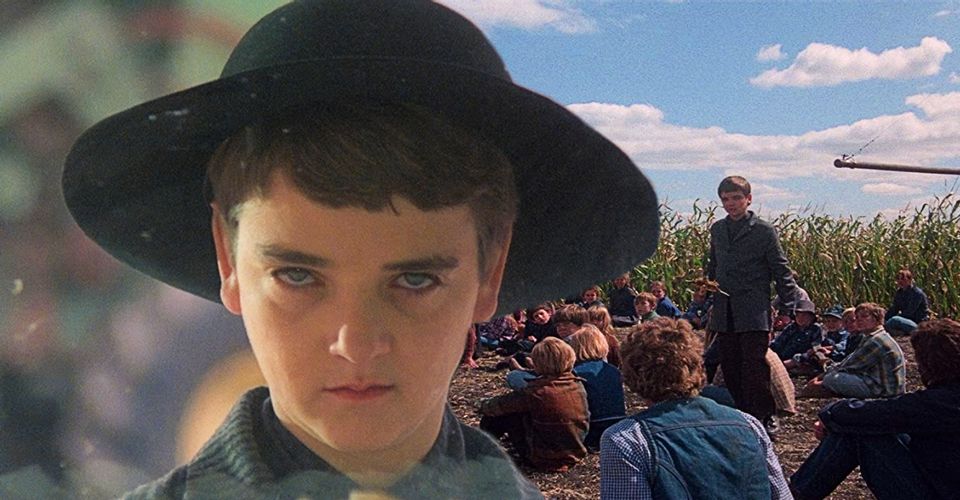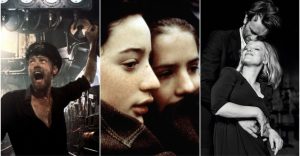Why Children of the Corn Needed The Short Story’s Dark Original Ending

The Stephen King short story Children of the Corn has a brutal original ending that the movie adaptation should have kept. Stephen King may be a horror icon, but not all of his stories have an easy journey from page to screen. Whether it is changing the vampiric villains of Salem’s Lot into mute bloodsuckers or reimagining the appearance of Pennywise the Dancing Clown, filmmakers tasked with bringing King’s literary nightmares to life have always taken creative liberties with the author’s work.
In some cases, these changes improve the work in question. Few fans of director Stanley Kubrick’s The Shining adaptation bemoaned the movie’s lack of sentient topiaries, and many fans of the novel It were relieved when its infamous “sewer scene” was absent from both the movie and miniseries adaptations. However, sometimes King’s adaptations miss the mark badly when it comes to changing their source stories, as proven by the movie version of Children of the Corn.
Released in 1984, the movie adaptation of Children of the Corn failed to recapture the creepy atmosphere and nightmarish tone of the original Stephen King short story from the collection Night Shift. Part of the problem was Children of the Corn’s failure to keep the shocking ending of King’s story intact, an issue that was understandable but resulted in a much milder, less effective horror. Admittedly, killing off both of the story’s heroes was a pretty brutal way for King’s tale to wrap up proceedings, but there are numerous reasons that the Children of the Corn movie adaptation should have kept the story’s original ending.
Children of the Corn’s Original Ending Explained

The basic buildup of Children of the Corn’s original short story and its later movie adaptation is the same. A bickering couple accidentally hit a child with their car on a remote country road, then drive to the abandoned town of Gatlin in search of help. However, like It’s movie adaptation and miniseries, the film version of Children of the Corn changes things after this point. In both versions of the story, the couple is split up upon their arrival in Gatlin and encounters a creepy corn-themed church before a group of cultist children kidnaps one of the story’s protagonists. However, in the original short story, the reader continues to follow the husband of the pair as he evades the kids and, the next time he encounters his wife, she has already been murdered by the cult.
Why Children of the Corn’s Movie Changed This Ending

In the movie version of Children of the Corn, the husband remains the primary POV Character, but the adaptation also adds two adorable children who wanted to escape the cult to help him in his search for his wife. The Stephen King short story adaptation then reunites the couple in time for the husband to save his wife, followed by the pair then defeating He Who Walks Among the Rows and successfully making it out of Gatlin with the two kids in tow in the movie’s happy ending. Presumably, the filmmakers thought that killing off the only sympathetic characters would be too cruel, especially when the survival of two small children now relied on him. However, jettisoning this depressing ending had a knock-on effect that made Children of the Corn’s attempts at horror much less successful.
Why Children of the Corn Needed Its Original Ending

The problem with changing the short story’s ending for the movie adaptation is that Children of the Corn’s premise is almost too ludicrous to be scary even in its truncated original form. Like Stephen King’s Maximum Overdrive, the Night Shift story becomes laughable when stretched to feature-length because conceits like killer kids and sentient trucks only work in short, self-contained stories. In its original short story form, the entirety of Children of the Corn teeters on the edge of absurdity, and the only things that make the tale terrifying (rather than comical) are its brevity and brutality. Just when viewers are ready to laugh at the idea of children being a threat to the story’s heroes, the lead character finds his wife’s corpse. Immediately after this, when viewers are certain that he will now take down the titular children in revenge, he is attacked by an unseen force far stronger than them in the story’s haunting ending.
The original Stephen King short story doesn’t leave readers any room to think about the logistics of the plot, since the whole thing becomes absurd under further inspection. However, despite the memorable opening sequence of Children of the Corn’s movie adaption (wherein the kids kill every adult in town in brutal fashion), the rest of the movie depicts them as children — incapable of stopping or killing the adults who stumble across their town and easily defeated by the movie’s bigger, stronger leading man. The short story’s brutal original ending was necessary for the titular threat to seem serious, and without it, Children of the Corn’s movie adaptation lacks a compelling antagonist.
How Children of the Corn Could Have Fixed This Problem (But Didn’t)

The children of Children of the Corn are not particularly threatening in the movie adaptation, thanks to their failure to kill The Terminator heroine Linda Hamilton’s leading lady. However, they are not the only villains in the original short story. He Who Walks Among the Rows (later confirmed to be recurring King antagonist Randall Flagg) is the unseen force to whom the children are feeding adult sacrifices. This villain does not suffer from the children’s problem of seeming too easily defeated to be scary. He Who Walks Among the Rows is a force of nature that seems almost godlike in its power, and the monster would have provided Children of the Corn’s adaptation with a compelling antagonist even without the movie killing off its leads. However, much like 2020’s The Stand ruined Randall Flagg, Children of the Corn’s movie adaptation turned He Who Walks Among the Rows into an unseen villain due to the movie’s limited budget. This change made the potentially terrifying villain laughable and resulted in Children of the Cornhaving no effective antagonist since the eponymous kids were too harmless to defeat the heroes and the unseen monster was barely even touched on in the Stephen King movie.
About The Author

















